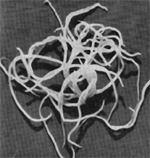There are two main families
of internal poultry pests.
These are:
1. Worms
2. Coccidia
Worms may well be the single most dangerous parasite for
the chook breeder to deal with and severe cases certainly weaken the birds sufficiently to
allow more serious diseases to break out. The most common worms found in chooks, are Round
worms and Tape worms.
Various drugs are used to treat your birds for worm
infestation. Most sheep drenches will work quite well, however the strength must be
diluted to about 2.5%. There are proprietry brands of poultry wormers such as Nilverm,
however it is best not to continue using the same drug on a long term basis as the worms
build a resistance if this is done. The best method is to alternate between two or more
different types of drench to avoid this happening.
Some fanciers like to use a drug called Piperazine,
however most worm strains now have a resistance to this particular compound. Other people
prefer to use more natural medicants. Garlic crushed into the feed is one such method, but
a better one is mixing apple cider vinegar into the drinking water. This also acts as a
tonic for the birds.
No matter what methods or drugs you use, it is
important that you keep your birds as worm-free as possible to maintain vigour and
vitality in your stock.
Coccidia are a group of eight different species of protozoan
organisms which sometimes infect chooks. The main variety Eimeria tenalla infects
the caeca and is the major cause coccidiosis chick mortality. When chicks are kept in
clean, dry conditions, coccidiosis is seldom a problem. However in damp, humid conditions
and if chicks are overcrowded, coccidiosis can become a very real threat. Chicks kept on
ground previously used for chickens that has not been properly cleaned and prepared will
also favour an outbreak.
The main symptom of caecal coccidiosis, is bloody
droppings. The birds will be depressed and huddle together in a crouched over position.
Their faces are pale due to the anaemia caused by the parasite. If left untreated, the
chicks will virtually bleed to death.
Treatment consists of a course of sulphaquinoxaline.
Some fanciers mix the preparation in the drinking water, however some chicks will not
drink medicated water and thus die. I prefer to mix the drug with water at a rate of about
10% and directly administer each chick with about 1/2ml using a syringe. This method
ensures that all chicks get equal doses and none miss out. Done this way, I have found
chicks recover much quicker. Another dose given about two days after the first, usually
gives a full recovery. It is important to minimise the risks of reinfection, by removing
the cause. Most commonly, faulty water containers are the main cause of dampness in a
brooder. |

Round worms

Tape worms

Life cycle of tapeworms
(1) scolex or head with
suckers and hooks,
(2-3) undifferentiated segments; (4-5-6) segments with male and female generative organs
(7) mature segments or proglottids with eggs; these drop off at intervals and carry on the
infestation, (A) droppings with proglottids, which crawl out and eaten by slugs, (B) small
embryo (oncosphere) armed with six hooks, (C) slug containing oncosphere, which develops
into- (D) encysted shape, which forms in the slug and is eventually eaten by a fowl, and
develops into a fully grown tapeworm (Davainea proglottina). |